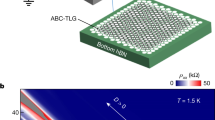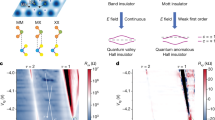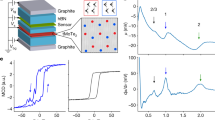Abstract
The Chern insulator displays a quantized Hall effect without Landau levels. Theoretically, this state can be realized by engineering complex next-nearest-neighbour hopping in a honeycomb lattice—the so-called Haldane model. Despite its profound effect on the field of topological physics and recent implementation in cold-atom experiments, the Haldane model has not yet been realized in solid-state materials. Here we report the experimental realization of a Haldane Chern insulator in AB-stacked MoTe2/WSe2 moiré bilayers, which form a honeycomb moiré lattice with two sublattices residing in different layers. We show that the moiré bilayer filled with two holes per unit cell is a quantum spin Hall insulator with a tunable charge gap. Under a small out-of-plane magnetic field, it becomes a Chern insulator with a finite Chern number because the Zeeman field splits the quantum spin Hall insulator into two halves with opposite valleys: one with a positive and the other with a negative moiré band gap. We also demonstrate experimental evidence of the Haldane model at zero external magnetic field by proximity coupling the moiré bilayer to a ferromagnetic insulator.
This is a preview of subscription content, access via your institution
Access options
Access Nature and 54 other Nature Portfolio journals
Get Nature+, our best-value online-access subscription
$29.99 / 30 days
cancel any time
Subscribe to this journal
Receive 12 print issues and online access
$209.00 per year
only $17.42 per issue
Buy this article
- Purchase on Springer Link
- Instant access to full article PDF
Prices may be subject to local taxes which are calculated during checkout





Similar content being viewed by others
Data availability
All other data are available from the corresponding authors on reasonable request. Source data are provided with this paper.
References
Klitzing, K. V., Dorda, G. & Pepper, M. New method for high-accuracy determination of the fine-structure constant based on quantized Hall resistance. Phys. Rev. Lett. 45, 494–497 (1980).
Haldane, F. D. M. Model for a quantum Hall effect without Landau levels: condensed-matter realization of the ‘parity anomaly’. Phys. Rev. Lett. 61, 2015–2018 (1988).
Chang, C.-Z. et al. Experimental observation of the quantum anomalous Hall effect in a magnetic topological insulator. Science 340, 167–170 (2013).
Sharpe, A. L. et al. Emergent ferromagnetism near three-quarters filling in twisted bilayer graphene. Science 365, 605–608 (2019).
Deng, Y. et al. Quantum anomalous Hall effect in intrinsic magnetic topological insulator MnBi2Te4. Science 367, 895–900 (2020).
Serlin, M. et al. Intrinsic quantized anomalous Hall effect in a moiré heterostructure. Science 367, 900–903 (2020).
Chen, G. et al. Tunable correlated Chern insulator and ferromagnetism in a moiré superlattice. Nature 579, 56–61 (2020).
Li, T. et al. Quantum anomalous Hall effect from intertwined moiré bands. Nature 600, 641–646 (2021).
Jotzu, G. et al. Experimental realization of the topological Haldane model with ultracold fermions. Nature 515, 237–240 (2014).
Kane, C. L. & Mele, E. J. Quantum spin Hall effect in graphene. Phys. Rev. Lett. 95, 226801 (2005).
Kane, C. L. & Mele, E. J. Z2 topological order and the quantum spin Hall effect. Phys. Rev. Lett. 95, 146802 (2005).
Hasan, M. Z. & Kane, C. L. Colloquium: topological insulators. Rev. Mod. Phys. 82, 3045–3067 (2010).
Qi, X. & Zhang, S. Topological insulators and superconductors. Rev. Mod. Phys. 83, 1057–1110 (2011).
Liu, C.-X., Qi, X.-L., Dai, X., Fang, Z. & Zhang, S.-C. Quantum anomalous Hall effect in Hg1-yMnyTe quantum wells. Phys. Rev. Lett. 101, 146802 (2008).
König, M. et al. Quantum spin Hall insulator state in HgTe quantum wells. Science 318, 766–770 (2007).
Knez, I., Du, R.-R. & Sullivan, G. Evidence for helical edge modes in inverted InAs/GaSb quantum wells. Phys. Rev. Lett. 107, 136603 (2011).
Fei, Z. et al. Edge conduction in monolayer WTe2. Nat. Phys. 13, 677–682 (2017).
Wu, S. et al. Observation of the quantum spin Hall effect up to 100 kelvin in a monolayer crystal. Science 359, 76–79 (2018).
Zhang, Y., Devakul, T. & Fu, L. Spin-textured Chern bands in AB-stacked transition metal dichalcogenide bilayers. Proc. Natl Acad. Sci. USA 118, e2112673118 (2021).
Pan, H., Xie, M., Wu, F. & Das Sarma, S. Topological phases in AB-stacked MoTe2/WSe2: Z2 topological insulators, Chern insulators, and topological charge density waves. Phys. Rev. Lett. 129, 056804 (2022).
Xie, Y.-M., Zhang, C.-P., Hu, J.-X., Mak, K. F. & Law, K. T. Valley-polarized quantum anomalous Hall state in moiré MoTe2/WSe2 heterobilayers. Phys. Rev. Lett. 128, 026402 (2022).
Rademaker, L. Spin-orbit coupling in transition metal dichalcogenide heterobilayer flat bands. Phys. Rev. B 105, 195428 (2022).
Devakul, T. & Fu, L. Quantum anomalous Hall effect from inverted charge transfer gap. Phys. Rev. X 12, 021031 (2022).
Katmis, F. et al. A high-temperature ferromagnetic topological insulating phase by proximity coupling. Nature 533, 513–516 (2016).
Zhao, W. et al. Magnetic proximity and nonreciprocal current switching in a monolayer WTe2 helical edge. Nat. Mater. 19, 503–507 (2020).
Wu, F., Lovorn, T., Tutuc, E. & Macdonald, A. H. Hubbard model physics in transition metal dichalcogenide moiré bands. Phys. Rev. Lett. 121, 026402 (2018).
Wu, F., Lovorn, T., Tutuc, E., Martin, I. & MacDonald, A. H. Topological insulators in twisted transition metal dichalcogenide homobilayers. Phys. Rev. Lett. 122, 086402 (2019).
Li, T. et al. Continuous Mott transition in semiconductor moiré superlattices. Nature 597, 350–354 (2021).
Andrei, E. Y. & MacDonald, A. H. Graphene bilayers with a twist. Nat. Mater. 19, 1265–1275 (2020).
Balents, L., Dean, C. R., Efetov, D. K. & Young, A. F. Superconductivity and strong correlations in moiré flat bands. Nat. Phys. 16, 725–733 (2020).
Liu, J. & Dai, X. Orbital magnetic states in moiré graphene systems. Nat. Rev. Phys. 3, 367–382 (2021).
Andrei, E. Y. et al. The marvels of moiré materials. Nat. Rev. Mater. 6, 201–206 (2021).
Wang, L. et al. Correlated electronic phases in twisted bilayer transition metal dichalcogenides. Nat. Mater. 19, 861–866 (2020).
Ghiotto, A. et al. Quantum criticality in twisted transition metal dichalcogenides. Nature 597, 345–349 (2021).
MacDonald, A. H. Introduction to the physics of the quantum Hall regime. Preprint at arXiv.org/cond-mat/9410047 (1994).
Lau, C. N., Bockrath, M. W., Mak, K. F. & Zhang, F. Reproducibility in the fabrication and physics of moiré materials. Nature 602, 41–50 (2022).
MacNeill, D. et al. Breaking of valley degeneracy by magnetic field in monolayer MoSe2. Phys. Rev. Lett. 114, 037401 (2015).
Wang, Z., Shan, J. & Mak, K. F. Valley- and spin-polarized Landau levels in monolayer WSe2. Nat. Nanotechnol. 12, 144–149 (2017).
Tao, Z. et al. Valley-coherent quantum anomalous Hall state in AB-stacked MoTe2/WSe2 bilayers. Preprint at arXiv.org/2208.07452 (2022).
Kennes, D. M. et al. Moiré heterostructures as a condensed-matter quantum simulator. Nat. Phys. 17, 155–163 (2021).
Wang, L. et al. One-dimensional electrical contact to a two-dimensional material. Science 342, 614–617 (2013).
Tang, Y. et al. Simulation of Hubbard model physics in WSe2/WS2 moiré superlattices. Nature 579, 353–358 (2020).
Regan, E. C. et al. Mott and generalized Wigner crystal states in WSe2/WS2 moiré superlattices. Nature 579, 359–363 (2020).
Hohenadler, M., Parisen Toldin, F., Herbut, I. F. & Assaad, F. F. Phase diagram of the Kane–Mele–Coulomb model. Phys. Rev. B 90, 085146 (2014).
Liu, G. B., Shan, W. Y., Yao, Y., Yao, W. & Xiao, D. Three-band tight-binding model for monolayers of group-VIB transition metal dichalcogenides. Phys. Rev. B 88, 085433 (2013).
Zhao, W. et al. Gate-tunable heavy fermions in a moiré Kondo lattice. Nature 616, 61–65 (2023).
Movva, H. C. P. et al. Density-dependent quantum Hall states and Zeeman splitting in monolayer and bilayer WSe2. Phys. Rev. Lett. 118, 247701 (2017).
Li, Y. et al. Measurement of the optical dielectric function of monolayer transition-metal dichalcogenides: MoS2, MoSe2, WS2, and WSe2. Phys. Rev. B 90, 205422 (2014).
Frank, T., Högl, P., Gmitra, M., Kochan, D. & Fabian, J. Protected pseudohelical edge states in Z2-trivial proximitized graphene. Phys. Rev. Lett. 120, 156402 (2018).
Gustafsson, M. V. et al. Ambipolar Landau levels and strong band-selective carrier interactions in monolayer WSe2. Nat. Mater. 17, 411–415 (2018).
Han, Z., Li, T., Zhang, L., Sullivan, G. & Du, R.-R. Anomalous conductance oscillations in the hybridization gap of InAs/GaSb quantum wells. Phys. Rev. Lett. 123, 126803 (2019).
König, M. et al. The quantum spin Hall effect: theory and experiment. J. Phys. Soc. Jpn 77, 031007 (2008).
Acknowledgements
We thank L. Fu, Y. Zhang and A. H. MacDonald for fruitful discussions. The work at Cornell was supported by the US Department of Energy, Office of Science, Basic Energy Sciences, under award no. DE-SC0019481 (transport studies); the Air Force Office of Scientific Research under award nos. FA9550-19-1-0390 (development of moiré superlattices proximity coupled to a 2D magnet) and FA9550-20-1-0219 (magneto-optical studies); and the National Science Foundation (NSF) under award no. DMR-1807810 (analysis). The work at Cornell was also funded in part by the Gordon and Betty Moore Foundation (grant https://doi.org/10.37807/GBMF11563). The work at the University of California at Santa Barbara was primarily supported by the Army Research Office under award no. W911NF-20-2-0166 and by the Gordon and Betty Moore Foundation EPIQS programme under award no. GBMF9471. The growth of the hBN crystals was supported by the Elemental Strategy Initiative of MEXT, Japan and CREST (JPMJCR15F3), JST. We used the Cornell NanoScale Facility, an NNCI member supported by NSF grant no. NNCI-2025233. We also acknowledge support from the David and Lucille Packard Fellowship (K.F.M.), the Kavli Postdoctoral Fellowship (W.Z.) and the Swiss National Science Foundation (P.K.).
Author information
Authors and Affiliations
Contributions
W.Z., Y.Z. and L.L. fabricated the devices. W.Z., K.K., Y.Z., L.L., C.L.T. and E.R. performed the electrical measurements and analysed the data. P.K., W.Z. and Z.T. carried out the optical measurements. K.K. performed the tight-binding model calculations. K.W. and T.T. grew the bulk hBN crystals. W.Z., K.K., J.S. and K.F.M. designed the scientific objectives and oversaw the project. All authors discussed the results and commented on the manuscript.
Corresponding authors
Ethics declarations
Competing interests
The authors declare no competing interests.
Peer review
Peer review information
Nature Physics thanks the anonymous reviewers for their contribution to the peer review of this work.
Additional information
Publisher’s note Springer Nature remains neutral with regard to jurisdictional claims in published maps and institutional affiliations.
Extended data
Extended Data Fig. 1 Nonlocal transport supporting the QSH insulator.
a, Nonlocal resistance \({R}_{{\rm{nl}}}\) as a function of top and bottom gate voltages at \(B=0\) and \(T=\)330 mK. The green and orange dashed lines denote, respectively, the electric field direction at fixed \(\nu =2\) and the filling factor direction at fixed \(E={E}_{c}\). b, Optical micrograph of Device 1. The top gate (TG) and bottom gate (BG) are outlined by a black and red dashed line, respectively. The scale bar is 5 \({\rm{\mu }}{\rm{m}}\). c, Schematics of the measurement geometry. The device is current (I) biased along the arrow direction. The voltage drop \({V}_{{\rm{nl}}}\) is measured at the other end of the device. \({R}_{{\rm{nl}}}\) is negligible except at \(\nu =2\). Before band inversion, \({R}_{{\rm{nl}}}\) cannot be probed appropriately because the current is practically zero; after band inversion, it grows with increasing electric field. This is consistent with the helical edge transport in a QSH insulator.
Extended Data Fig. 2 QSH effect in devices of different twist angles.
a, b, Longitudinal resistance as a function of top and bottom gate voltages of Device 3 (2-degree twisted) at T = 300 mK (a) and Device 2 (near 0-degree twisted) at T = 10 mK (b). c, Two-terminal resistance measured by adjacent contacts as a function of top and bottom gate voltages of a bilayer MoTe2/monolayer WSe2 Device 4 (near 0-degree twisted) at T = 1.6 K. d-f, Line-cuts of a-c at varying top gate voltages. The grey dashed lines mark the quantized resistance \(\frac{h}{{2e}^{2}}(\)≈12.9 kΩ). For Device 3, \({R}_{{\rm{xx}}}\) at \(\nu =2\) is the smallest right after band inversion and plateaus with further increase of the electric field. \({R}_{{\rm{xx}}}\) and \({R}_{2{\rm{p}}}\) increase continuously with electric field after band inversion for Device 2 and 4, respectively.
Extended Data Fig. 3 Magneto-transport in Device 1 at 1.6 K.
a, b, Hall resistance as a function of the top and bottom gate voltages at B = 3 T (a) and of the magnetic field and filling factor at \(E={E}_{c}\) (b). The orange dashed line in a corresponds to \(E={E}_{c}\). The green dashed line in b marks the \({R}_{{\rm{xy}}}\) maximum. We determine the slope of the dashed lines to be \({n}_{{\rm{M}}}\frac{dv}{dB}=c\frac{e}{h}\) with c = 1.1 ± 0.1. Right inset shows the magnetic-field dependence of \({R}_{{\rm{xy}}}\) along the green dashed line.
Extended Data Fig. 4 Transport under different magnetic fields for Device 2.
a-e, Hall resistance (left) and longitudinal resistance (right) at 10 mK (lattice temperature) as a function of the top and bottom gate voltages. The magnetic field is 0.5 T (a), 1 T (b), 2 T (c, same as Fig. 3a of the main text), 3 T (d), 4 T (e).
Extended Data Fig. 5 High-magnetic-field transport.
a, \({R}_{{\rm{xy}}}\) (top) and \({R}_{{\rm{xx}}}\) (bottom) of Device 2 as a function of top and bottom gate voltages at B = 11.8 T and T = 10 \({\rm{m}}\)K (lattice temperature). The Landau levels (identified by the resistance minimum) are indexed. b, c, \({R}_{{\rm{xy}}}\) (top) and \({R}_{{\rm{xx}}}\) (bottom) as a function of filling factor and magnetic field at E = 0.435 V/nm (before band inversion, b) and at E = 0.463 V/nm (near band inversion, c). The dashed lines show the Landau fan. The white oval shows the Landau level that disperses with a negative slope.
Extended Data Fig. 6 The electric-field span of the Chern state as a function of magnetic field.
a, \({R}_{{\rm{xy}}}\) and \({R}_{{\rm{xx}}}\) of Device 2 at \(\nu =2\) and T = 10 mK (lattice temperature) as a function of electric field. The data are extracted from Extended Data Fig. 4. b, The electric-field span, \(\Delta E\), of the Chern state as a function of magnetic field. For each magnetic field, the electric-field dependence of \({R}_{{\rm{xy}}}\) is fit with a Gaussian function and \(\Delta E\) is determined as half of the variance. The error bars are one-sigma uncertainty of \(\Delta E\) in the Gaussian function fitting. The red dashed line is the best fit to \(\Delta E=\sqrt{{a}^{2}+{({bB})}^{2}}\) with fitting parameters a = 2.2 ± 0.1 mV/nm and b = 2.0 ± 0.1 mV/nmT.
Extended Data Fig. 7 Tight-binding model calculations.
a-c, Band structure simulated using the tight-binding Hamiltonian described in Methods. Red and blue curves denote the spin-up and spin-down bands, respectively. Under zero magnetic field (a), the bands are inverted at both the \({\rm{K}}\) and \({{\rm{K}}}^{{\prime} }\) valleys. This is a QSH insulator (QSHI). Under a small magnetic field (b), the bands in the \({{\rm{K}}}^{{\prime} }\) valley cross at one momentum. Under a sufficiently high magnetic field (c), the gap changes sign for the \({{\rm{K}}}^{{\prime} }\) valley; this is a Chern insulator. d, The direct band gap near the \({\rm{K}}/{{\rm{K}}}^{{\prime} }\) valleys as a function of the Zeeman energy and the sublattice/interlayer potential difference. The three symbols mark the phase space for which the electronic band structure is represented in a-c, respectively.
Extended Data Fig. 8 RC and MCD spectrum in AB-stacked MoTe2/WSe2 proximity-coupled to bilayer CrBr3.
a, Schematic side view of a dual-gated device of AB-stacked MoTe2/WSe2 moiré bilayer proximity-coupled to bilayer CrBr3. b, Bottom gate voltage dependence of the RC spectrum near the WSe2 intralayer exciton resonance for Vtg = −3.6 V. The strong feature near 1.67 eV is the neutral exciton resonance. It evolves into much weaker charged exciton resonances for \({V}_{{\rm{bg}}} < -1{\rm{V}}\). c, Bottom gate voltage dependence of the spontaneous MCD spectrum near the WSe2 exciton resonance at Vtg = −3.9 V. At this value of \({V}_{{\rm{tg}}}\), the WSe2 layer is doped for the entire range of bottom gate voltage. The MCD reported in the main text is spectrally integrated over the spectral window given by the black dashed lines (1.661–1.666 eV), which covers the attractive polaron resonance of WSe2.
Source data
Source Data Fig. 2
Statistical source data for Fig. 2.
Source Data Fig. 3
Statistical source data for Fig. 3.
Source Data Fig. 4
Statistical source data for Fig. 4.
Source Data Fig. 5
Statistical source data for Fig. 5.
Rights and permissions
Springer Nature or its licensor (e.g. a society or other partner) holds exclusive rights to this article under a publishing agreement with the author(s) or other rightsholder(s); author self-archiving of the accepted manuscript version of this article is solely governed by the terms of such publishing agreement and applicable law.
About this article
Cite this article
Zhao, W., Kang, K., Zhang, Y. et al. Realization of the Haldane Chern insulator in a moiré lattice. Nat. Phys. 20, 275–280 (2024). https://doi.org/10.1038/s41567-023-02284-0
Received:
Accepted:
Published:
Issue Date:
DOI: https://doi.org/10.1038/s41567-023-02284-0
This article is cited by
-
Optical readout of the chemical potential of two-dimensional electrons
Nature Photonics (2024)
-
Light-induced switching between singlet and triplet superconducting states
Nature Communications (2024)
-
Evidence of the fractional quantum spin Hall effect in moiré MoTe2
Nature (2024)
-
Dual quantum spin Hall insulator by density-tuned correlations in TaIrTe4
Nature (2024)



